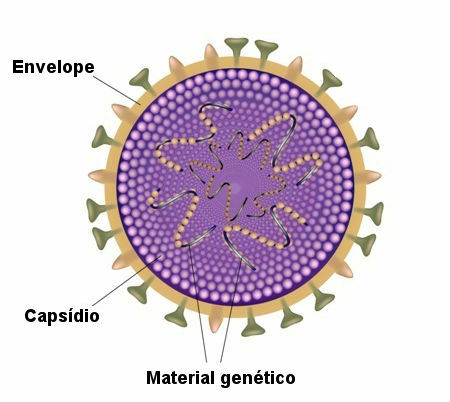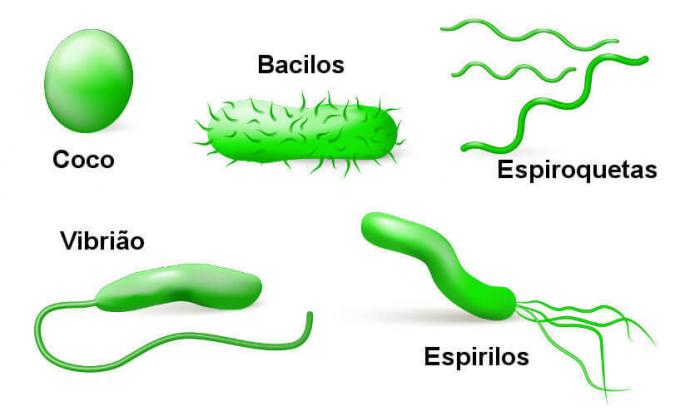viruses are organismsmuchsimple that stand out for the absence of cells. They are well known for the illnesses that cause human beings, however, it is important to know that some are harmless to man. Next, we will better describe the characteristics, structure and way in which viruses reproduce.
→ Features
Viruses, a word derived from Latin virus meaning "poison" or "toxin", are extremely small microscopic organisms that have a size that can range from about 20 to 300 nm. To get an idea of this size, viruses that are about 20 nm in diameter are smaller than the ribosome, a small cellular structure responsible for protein synthesis. Because of this small size, most of the time, they can only be seen through an electron microscope.
The most striking feature of viruses is the absenceincells. Therefore, they also lack important organelles, for example ribosomes, which produce proteins; not even enzymes, which are needed to carry out various reactions. An interesting feature is the fact that viruses can be crystallized, which is not seen in cells.
Due to the absence of cells and a metabolic machinery, viruses are unable to reproduce on their own, so it is essential to parasitize a cell for this to happen. As a result of this characteristic, viruses are called obligate intracellular parasites.

See some examples of well-known viruses.
Viruses have materialgenetic, most of the time, either RNA or DNA. In case of mimivirus,we have an unusual situation, since both DNA and RNA are observed in it. Another peculiar feature is that the genetic material of viruses can be double-stranded DNA, single-stranded DNA, double-stranded RNA or single-stranded RNA.
→ Virus structure
The structure of viruses is quite simple when we compare it with any organism possessing cells. We can say that viruses are particles made up of genetic material surrounded by a protein layer. In some cases, there is also a membranous envelope surrounding the protein capsule. See below for more about each of these parts:

Look closely at the main parts of viruses.
Genetic material: In viruses, we find DNA, RNA, or both combined. Viruses that have DNA are called DNA viruses and those that have RNA are called RNA viruses.
Capsidium: The capsid is a capsule formed by proteins that surround the genetic material. It has different shapes and is formed by small subunits called capsomeres.
Envelope: The envelopes found in viruses are usually derived from the plasma membrane of the cell where the virus reproduced. This envelope contains phospholipids and membrane proteins, in addition to proteins and glycoproteins that have a viral origin.
→ Viruses are alive or not?
You virus they are organisms considered by many to be lifeless organisms. However, a portion of researchers believe that viruses are alive, but with some differences. Those who argue that viruses are not living things rely on the following evidence:
Viruses do not have cells, that is, they are acellular. This contradicts the cell theory, which says that all living things have cells, so viruses could not be considered alive.
Viruses can only reproduce inside a cell.
Viruses do not have their own metabolism.
Those who believe that viruses are alive are based on the following ideas:
Viruses have genetic material.
Viruses are capable of undergoing changes over time, that is, they are able to evolve.
readalso:Characteristics of a living being
→ Virus reproduction
As stated earlier, the virus is unable to reproduce independently, so the participation of a cell is essential. Each virus has the ability to infect a specific type of cell and, therefore, it is said to have host specificity.
Initially, the virus identifies the cell that will be parasitized, and later it ensures that the viral genome enters the cell. This step varies from one virus to another, while some inject genetic material into the host cell, others literally enter the cell.
When the viral material is inside the cell, it starts to be replicated by the host and, later, the ribosomes synthesize the viral proteins. The host cell also ensures that the virus's genetic material is produced, as well as the capsomeres, which form the capsids. When these viruses are ready, they leave the host cell, causing that cell's destruction.

Note above the reproductive cycle of a bacteriophage virus.
When we observe the reproductive cycles of bacteriophages, which parasitize bacteria, we observe two mechanisms: the lytic cycle and the lysogenic cycle.
Lithic cycle: In the lytic cycle, we observe 5 basic steps: adhesion; entry of phage DNA and degradation of host DNA; synthesis of virus genetic material and proteins; assembly and release. Upon release, the bacterial cell breaks down and new viruses are released.
Lysogenic cycle: In the lysogenic cycle, the viral genetic material is replicated, but the host cell is not destroyed. The viral genetic material becomes part of the infected cell's DNA, and at each cell division this viral material is passed on to the daughter cells.
→ Virus Diseases

Dengue is a disease caused by a virus.
Viruses are well known for illnesses that cause. Most of these illnesses cause fever, headaches, body aches, malaise and poor appetite. Examples of diseases caused by viruses are:
AIDS;
Chickenpox;
Dengue;
Yellow fever;
The flu;
Hepatitis;
Anger;
Cold;
Rotavirus;
Rubella;
Measles.
Read too: Differences between flu and cold
The vast majority of these diseases do not have specific medications, generally, the use of medications to alleviate the symptoms of the disease, such as fever and pain, is recommended. In case of viral disease, the main recommendation is that the patient rest, hydrate and have a healthy diet.
As there are several diseases caused by viruses, it is not possible to describe all forms of prevention, as some have specific ways. However, in general, we can mention some measures that can reduce the chances of acquiring some of these diseases. Are they:
get vaccinated;
Have good personal hygiene;
Avoid contact with patients;
Eating well;
Drink plenty of water.
Watch our video class related to the subject:


